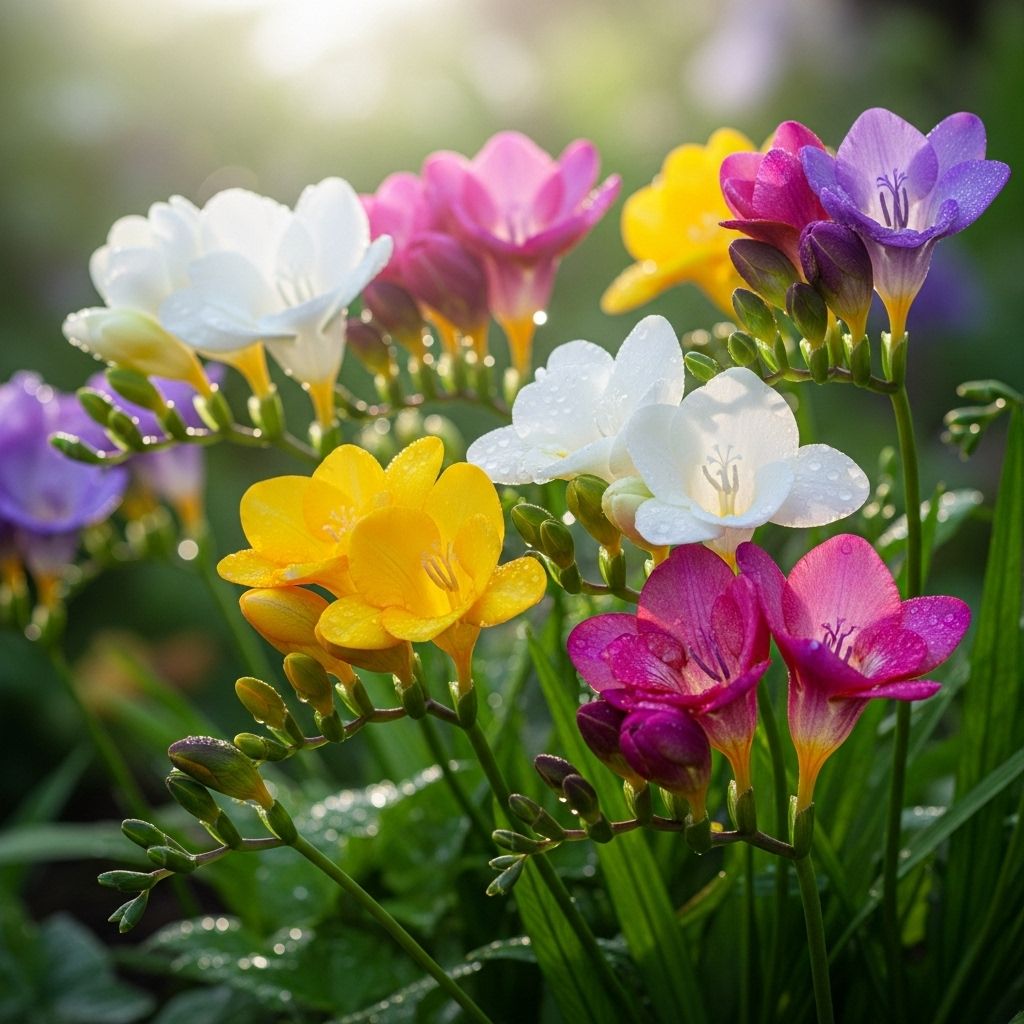How To Grow Freesia: A Complete Guide To Fragrant Blooms
Discover how to successfully grow these exotic, fragrant bloomers indoors and outdoors

Image: HearthJunction Design Team
Growing Fragrant Freesia Flowers: A Complete Guide
Bright, colorful, and delightfully fragrant, freesia flowers have long been beloved in florist shops for their intoxicating scent, impressive vase life, and stunning array of jewel-toned colors. But why limit yourself to occasional store-bought bouquets when you can grow these exotic bloomers right in your own home or garden? Despite their elegant appearance, freesias are surprisingly easy to grow and can provide months of sensory pleasure with their sweet perfume and delicate floral beauty.
These welcome winter bloomers make excellent forced indoor plants, serving as inexpensive, longer-lasting alternatives to cut flowers. Beyond their value as houseplants, freesias can also thrive outdoors in garden beds or containers when planted at the appropriate time. Let’s explore everything you need to know about cultivating these magnificent flowers.
Understanding Freesia Plants
Freesias are corm-producing plants that originate from South Africa. Their funnel-shaped blooms appear on graceful stems that often arch slightly under the weight of their fragrant flowers. Available in a wide spectrum of colors including white, yellow, orange, red, pink, purple, and even bi-colored varieties, freesias offer something for every garden palette.
What sets freesias apart from many other flowering bulbs is their intense fragrance, often described as a sweet, citrusy scent that can fill an entire room. This characteristic makes them particularly valuable as indoor plants during the winter months when other fragrant flowers may be scarce.
Indoor Growing: Forcing Freesia Bulbs
One of the greatest joys of growing freesias is their ability to be forced into bloom indoors during winter months, bringing color and fragrance to your home when the outdoor garden lies dormant. Here’s how to successfully grow freesias indoors:
When to Plant for Indoor Growing
Timing is crucial when forcing freesia bulbs. For indoor growing, you have two main options:
- Plant in fall (mid-August to late October) for flowers from January through April
- Plant from January to March for early summer flowering
Choosing and Preparing Containers
Select containers that have adequate drainage holes to prevent waterlogging, which can cause the corms to rot. Clay or terracotta pots work well as they allow excess moisture to evaporate through their porous surfaces.
Fill your chosen containers with well-draining potting mix. A good option is to use a soil-based potting compost mixed with approximately one-quarter to one-third by volume of coarse grit to ensure proper drainage.
Planting Freesia Corms Indoors
When planting freesia corms in pots, follow these steps:
- Fill the pot with the prepared potting mix to about 2 inches below the rim
- Place the corms with the pointed end facing up, about 1-2 inches deep
- Space the corms approximately 2-3 inches apart
- Cover with potting mix and water thoroughly
- Place small stakes in the pot to support the stems as they grow
Indoor Care Requirements
After planting, place the pots in a cool, shaded, frost-free location with a temperature around 5°C (41°F) for 3-4 weeks. Once shoots appear, move the pots to a warmer, sunnier position.
Keep the soil evenly moist but not soggy. Freesia corms can rot in waterlogged conditions, so allow the soil surface to dry slightly between waterings. As flower spikes emerge, provide support with small stakes to prevent them from toppling over.
Outdoor Planting in the Garden
Freesias can create a stunning display in garden beds and borders when planted at the right time and given proper care. Here’s how to grow them successfully outdoors:
When to Plant Outdoors
In most climates, plant freesias outdoors in spring for summer flowers. In milder regions, fall planting may be possible for spring blooms, but remember that freesias aren’t frost-hardy. Only plant outdoors when all danger of frost has passed, typically from April to June in temperate regions.
Choosing the Right Location
Freesias thrive in full sun positions with well-drained, fertile soil. They perform best in sheltered locations protected from strong winds that could damage their delicate stems. If your garden soil is heavy clay or prone to waterlogging, consider growing freesias in raised beds or containers instead.
Soil Preparation
Prepare the planting area by enriching the soil with plenty of organic matter such as well-rotted compost or manure. This improves both fertility and drainage, creating ideal conditions for freesia growth. If your soil is particularly heavy, incorporate coarse grit or sharp sand to enhance drainage.
Planting Process
When planting freesia corms in the garden, follow these guidelines:
- Plant corms 1-2 inches deep with the pointed end facing upward
- Space corms 2-3 inches apart
- For visual impact, plant in groups of at least six corms
- Add stakes at planting time to support stems when they flower
- Water thoroughly after planting
Outdoor Care Requirements
| Care Aspect | Requirements |
|---|---|
| Sunlight | Full sun |
| Watering | Keep soil evenly moist during growing season; allow to dry slightly between waterings |
| Fertilizing | Apply balanced fertilizer every few weeks during growing season |
| Support | Provide stakes for flower-laden stems |
| Pests & Diseases | Monitor for aphids, thrips, and rot issues |
Choosing Quality Freesia Corms
The quality of your freesia corms significantly impacts your growing success. Larger corms contain more stored energy and will produce more stems and more abundant blooms. When purchasing freesia corms, look for firm, plump specimens without signs of damage, mold, or shriveling.
If you’re selecting corms in person, compare sizes and always choose the largest available within your budget. When ordering online, reputable suppliers will often specify the size of corms they provide.
Caring for Blooming Freesias
Once your freesias begin to bloom, a few simple care practices will help extend their flowering period and maximize your enjoyment:
Supporting Flowering Stems
As freesia stems grow taller and develop flower buds, they may need additional support to prevent bending or breaking. Thin bamboo stakes or specialized flower supports work well. Gently secure stems to the supports using soft plant ties or natural twine, being careful not to damage the delicate stems.
Deadheading
Remove spent flowers promptly to encourage the plant to produce more blooms and prevent energy from being diverted to seed production. Simply pinch or snip off faded flowers just below where they join the stem.
Post-Flowering Care
After flowering completes, continue watering and fertilizing if you plan to save the corms for next season. Allow the foliage to die back naturally, as this process returns valuable nutrients to the corm. Once foliage has yellowed completely, you can dig up the corms, clean off excess soil, and store them in a cool, dry place until the next planting season.
Common Problems and Solutions
While freesias are generally easy to grow, they can occasionally face challenges. Here are some common issues and how to address them:
Rotting Corms
Excessive moisture is the primary cause of rotting freesia corms. Ensure your growing medium has excellent drainage and avoid overwatering. If you notice signs of rot (softening corms or foul odors), remove affected corms immediately to prevent spread.
Failure to Bloom
If your freesias produce foliage but no flowers, the most common causes are insufficient light, improper chilling period, or depleted corms. Ensure plants receive adequate sunlight, provide the recommended cool period before moving to warmer conditions, and always start with high-quality corms.
Pest Issues
Aphids and thrips can occasionally trouble freesia plants. Monitor regularly and treat with insecticidal soap or neem oil if pests appear. For indoor plants, increasing air circulation can help discourage pest issues.
Using Freesias in Floral Arrangements
One of the greatest rewards of growing freesias is their value in cut flower arrangements. Their long vase life (often 7-14 days) and incredible fragrance make them perfect for indoor displays. For best results when cutting freesias:
- Cut stems when the first 1-2 buds are just beginning to open
- Cut early in the morning when stems are well-hydrated
- Place immediately in clean water with floral preservative
- Position arrangements away from direct sunlight and ripening fruit
Frequently Asked Questions (FAQs)
Q: Can freesia corms be reused year after year?
A: Yes, freesia corms can be reused, though they may produce fewer or smaller blooms in subsequent years. After flowering, allow the foliage to die back naturally, then dig up the corms, clean off soil, and store in a cool, dry place until the next planting season.
Q: Why are my freesia plants growing tall but not flowering?
A: This is typically due to insufficient light, improper temperature cycling, or depleted corms. Ensure plants receive plenty of sunlight, provide the recommended cool period followed by warmer conditions, and start with high-quality corms.
Q: Are freesias deer-resistant?
A: Freesias are generally considered deer-resistant due to their fragrance, though no plant is completely deer-proof in areas with high deer pressure or during food scarcity.
Q: Can freesias be grown in containers outdoors?
A: Yes, freesias grow excellently in containers outdoors. Use well-draining potting mix, ensure containers have drainage holes, and follow the same care guidelines as for garden planting.
Q: How long do freesia flowers last?
A: On the plant, individual freesia flowers typically last 7-10 days, with the entire flower spike providing bloom for 2-3 weeks as buds continue to open. As cut flowers, they can last 7-14 days with proper care.
References
- https://www.gardendesign.com/bulbs/freesia.html
- https://www.longfield-gardens.com/article/all-about-freesia/
- https://www.gardenersworld.com/how-to/grow-plants/how-to-grow-freesias/
- https://www.seedlingsquad.com/articles-post/how-to-grow-freesia-a-beginners-guide-to-fragrant-blooms
- https://www.homesandgardens.com/gardens/how-to-plant-freesia-bulbs
Read full bio of Shinta












